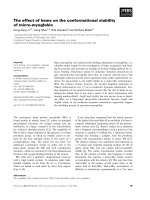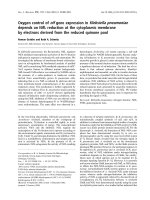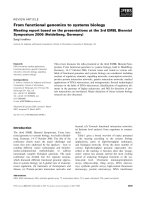The effect leaving money on the table at
Bạn đang xem bản rút gọn của tài liệu. Xem và tải ngay bản đầy đủ của tài liệu tại đây (2.27 MB, 132 trang )
The effect leaving money on the table at
IPO has on future performance for Tech
companies.
Written by
Darren Clarke
1720642
MBA Finance
Dublin Business School
May 2015
Title: The effect leaving money on the table at IPO has on future performance for Tech
companies.
Research Question: Does leaving money on the table at IPO for Tech companies help or
hinder future performance?
Publication date: May 22nd 2015
Author: Darren Clarke
Supervisor: Andrew Quinn
Level: MBA in Finance
Number of words: 19,987 excluding Title Page, Table of Contents, List of Tables/Charts,
and Bibliography.
Number of pages: 132
Keywords: LinkedIn, Facebook, Twitter, GoPro, Alibaba, Box, Intial Public Offering (IPO),
under pricing, money left on the table, technology sector, social media, share price,
quantitative study.
2
Table of Contents
LIST OF TABLES/CHARTS ........................................................................ 6
ACKNOWLEDGEMENTS ............................................................................ 8
ABSTRACT .................................................................................................... 9
CHAPTER 1: INTRODUCTION ................................................................... 10
CHAPTER 2: LITERATURE REVIEW ........................................................ 12
2.1 Initial Public Offering Description and Purpose ............................ 12
2.2 Under-Pricing and “Money left on the table” ................................ 13
2.3 LinkedIn: Company Background and IPO reaction ....................... 15
2.4 Facebook: Company Background and IPO reaction ...................... 18
2.5 Twitter: Company Background and IPO reaction .......................... 24
2.6 GoPro: Company Background and IPO reaction ........................... 28
2.7 Alibaba: Company Background and IPO reaction ......................... 31
2.8 Box Inc: Company Background and IPO reaction ......................... 37
2.9 Summary ......................................................................................... 41
CHAPTER 3: RESEARCH METHODOLOGY ............................................ 42
3.1 Introduction..................................................................................... 42
3.2 Research Questions......................................................................... 42
3.3 Proposed Methodology ................................................................... 43
3.4 Research Philosophy....................................................................... 43
3.5 Research Approach ......................................................................... 46
3
3.6 Research Strategy ........................................................................... 47
3.7 Research Choice ............................................................................. 48
3.8 Time Horizon .................................................................................. 49
3.9 Data Collection Method.................................................................. 50
3.10 Sampling Selection ....................................................................... 50
3.11 Research Ethics............................................................................. 52
3.12 Research Limitations .................................................................... 52
CHAPTER 4: DATA ANALYSIS, ................................................................ 53
4.1 Introduction..................................................................................... 53
4.2 LinkedIn: Post IPO Share Price Analysis ....................................... 53
4.3 LinkedIn: Market Comparison Analysis ........................................ 63
4.4 LinkedIn: Summary ........................................................................ 65
4.5 Facebook: Post IPO Share Price Analysis ...................................... 66
4.6 Facebook: Market Comparison Analysis ....................................... 74
4.7 Facebook: Summary ....................................................................... 74
4.8 Twitter: Post IPO Share Price Analysis.......................................... 76
4.9 Twitter: Market Comparison Analysis ........................................... 80
4.10 Twitter: Summary ......................................................................... 83
4.11 GoPro: Post IPO Share Price Analysis ......................................... 84
4.12 GoPro: Market Comparison Analysis .......................................... 88
4.13 GoPro: Summary .......................................................................... 88
4.14 Alibaba: Post IPO Share Price Analysis ....................................... 89
4
4.15 Alibaba: Market Comparison Analysis ........................................ 91
4.16 Alibaba: Summary ........................................................................ 91
4.17 Box: Post IPO Share Price Analysis ............................................. 93
4.18 Box: Market Comparison Analysis .............................................. 93
4.19 Box: Summary .............................................................................. 93
4.20 Comparison of all Companies ...................................................... 96
CHAPTER 5: CONCLUSIONS ..................................................................... 106
CHAPTER 6: RECOMMENDATIONS FOR FUTURE RESEARCH ........ 110
CHAPTER 7: REFLECTIONS ON LEARNING ......................................... 111
BIBLIOGRAPHY ........................................................................................... 116
5
List of Tables/Charts
Table 1: Overview of Companies’ IPOs
P14
Table 2: LinkedIn – Price Movement after Earnings Reports
P55
Table 3: Facebook – Price Movement after Earnings Reports
P66
Table 4: Twitter – Price Movement after Earnings Reports
P76
Table 5: GoPro – Price Movement after Earnings Reports
P84
Table 6: Alibaba – Price Movement after Earnings Reports
P89
Table 7: Price/Earnings for each company
P96
Table 8: Price/Book ratio for all companies
P98
Table 9: Price/Sales ratio for all companies
P99
Chart 1: LinkedIn Share Price History
P54
Chart 2: LinkedIn Share Price for Q2 2011 - Q1 2012
P57
Chart 3: LinkedIn Share Price for Q2 2012 - Q1 2013
P58
Chart 4: LinkedIn Share Price for Q2 2013 - Q1 2014
P61
Chart 5: LinkedIn Share Price for Q2 2014 - Q1 2015
P62
Chart 6: LinkedIn Market Comparison Analysis
P64
Chart 7: Facebook Share Price History
P68
Chart 8: Facebook Share Price for Q2 2012 - Q1 2013
P70
Chart 9: Facebook Share Price for Q2 2013 - Q1 2014
P72
Chart 10: Facebook Share Price for Q2 2014 - Q1 2015
P73
Chart 11: Facebook Market Comparison Analysis
P75
Chart 12: Twitter Share Price History
P77
Chart 13: Twitter Share Price for Q4 2013 - Q2 2014
P79
Chart 14: Twitter Share Price for Q3 2014 - Q1 2015
P81
6
Chart 15: Twitter Market Comparison Analysis
P84
Chart 16: GoPro Share Price History
P86
Chart 17: GoPro Market Comparison Analysis
P87
Chart 18: Alibaba Share Price History
P90
Chart 19: Alibaba Market Comparison Analysis
P92
Chart 20: Box Share Price History
P94
Chart 21: Box Market Comparison Analysis
P95
Chart 22: All Share Price since May 2011
P101
Chart 23: Price Movement after IPO - 1 Year
P102
Chart 24: Price Movement after IPO - 2 Years
P103
Chart 25: Price Movement after IPO - To date
P104
7
Acknowledgements
First and foremost, I would like to express my gratitude to my supervisor Andrew Quinn. I
wish to thank him for all the time and effort he has spent guiding me throughout the
dissertation. He has imparted his knowledge and experience of financial markets as my
lecturer of International Financial Institutions and Markets. His enthusiasm and interest aided
me in the completion of the dissertation.
Many thanks go to all other lecturers and staff in Dublin Business School who transmitted
their knowledge help and assistance throughout completing the MBA in Finance. The
facilities provided by Dublin Business were also a significant help during my studies.
Thank you to my fiancée Amy who has supported me lovingly throughout my time studying
at Dublin Business School. She has been there for me during stressful times before exams and
meeting deadlines and I would not have been able to do it without her love and
understanding.
I would also like to thank my father Sean for supporting me throughout my life and giving
me the opportunity and encouragement to further myself through education and help me
become a better person.
Special thanks go to all staff at Mohill Computer Training and Mohill Enterprise Centre who
provided learning of computer skills that aided my development through my studies. I would
also like to thank them for assisting me with printing and binding for my dissertation.
To all the people who contributed directly or indirectly to this dissertation, many thanks.
8
Abstract
The definition of a successful Initial Public Offering (IPO) is a point of fervent debate among
analysts in the financial sector. Many analysts are of the opinion that a successful IPO is
defined by the size of the IPO pop in price on the first day. Other analysts believe that if there
is a large pop in price then money is left on the table as the company under prices the IPO
and misses out on potentially raising more money.
This is even more prevalent when a company is in a new industry like technology, social
media or internet. Companies in these industries are new and often have no profits but a
rapidly expanding user base with the possibility of large future revenues and profits. These
companies are difficult to value using traditional revenue or profit based metrics. Therefore
pricing an IPO is more difficult for these types of companies and their IPOs are often under
priced in the hope of a pop.
The purpose of this study is to investigate whether an IPO pop is beneficial in the long term
to companies in aforementioned industries. This study focuses on the following companies
that went public between 2011 and 2015; LinkedIn, Facebook, Twitter, GoPro, Alibaba and
Box Inc.
To implement this study, data was collected from the share price of each company after their
IPO. Their performance is measured against one another and analysed in tandem with the
amount that each company under priced their IPO.
The results indicate that although an IPO is an important part of a company’s growth and has
an impact in the short term, the longer term share price is affected by revenues, profits and
growth prospects that are announced at earnings reports. Therefore leaving money on the
table does not help share price performance in the long term.
9
Chapter 1: Introduction
Initial Public Offerings (IPO) consistently provide an air of excitement and occasion within
the finance community.
An IPO is a significant stage in a company’s growth, raising
considerable capital to fund future growth. They are additionally regarded as a long awaited
“payday” for the founders, venture capitalists and angel investors who gain significantly from
their investment of innovation, expertise and resources.
Social Media sites, such as LinkedIn, Facebook and Twitter have revolutionised the world,
particularly how people connect and communicate with each other. Hundreds of millions of
people across the globe utilise these sites daily, accessing real time news, researching
employment opportunities and promoting organisations, such as businesses, sports clubs and
charities. Such sites are now an integral part of how the world communicates, both socially
and professionally.
Naturally, this intense level of global interest in Social Media sites generates immense
interest and excitement when these companies go to IPO. Such interest flows not only
through the financial community, but across society in general.
Other technology companies such as Alibaba, Box and GoPro are new companies that have
also excited investors and consumers alike. Alibaba is a Chinese internet company that has
billions of sales in China and is moving towards USA. GoPro has taken the personal camera
market by storm after smart phones had made many personal cameras obsolete. Box is an
innovative company in the new cloud storage industry.
Therefore this research study will be of interest to a wide section of society, providing benefit
to many, including shareholders and managers in pre-IPO companies, investors who trade
shares at IPO’s and organisations dealing generally with IPOs, such as underwriting banks,
stock exchanges and the financial community as a whole.
10
The outcome of IPO’s are fervently debated as individual opinion on what constitutes
success, differs considerably. One aspect surrounds the amount of capital that was “left on
the table” at individual IPOs. Simply, this dictates how companies under-price their IPO
shares. Thus, the amount that is forgone by setting the IPO price below the level that the
market is willing to pay. This dissertation aims to answer the underlying research question.
“Does the amount money left on the table at IPO affect future performance for Tech
companies?”
Although, extensive research has been conducted concentrating upon IPO under-pricing,
LinkedIn, Facebook, Twitter, GoPro, Alibaba and Box are relatively new companies with
very recently completed IPO’s. Thus little research, specific to this particular industry has
been conducted. Box’s IPO expressly, was completed less than six months ago ensuring the
fresh and current spine of this research.
The literature review in chapter 2 will provides an understanding of the IPOs of each
company and how analysts reacted. Due to the current nature of the topic, much of this
secondary information was sourced from online media reports.
Chapter 3 outlines the most appropriate method of researching this topic and what research
strategies lend itself to this type of research.
To fully answer the research question above, the analysis of each company’s financial
performance will be contained in chapter 4, data results and findings. Conclusions are made
in chapter 5 based on the findings of chapter 4 and this leads to a final conclusion of this
dissertation.
11
Chapter 2: Literature Review
2.1 Initial Public Offering Description and Purpose
Geddes (2003) describes an Initial Public Offering (IPO) as a company’s endeavour to list on
the stock exchange and sell its shares to the public for the first time. Espinasse (2011)
denotes that an IPO is primarily utilised to raise capital and finance future development. He
offers additional objectives, such as increasing company profiles, attaining market prestige
and reducing company gearing levels. Koba (2013) concurs with this while also adding that
public company status allows the recruitment and rewarding of employees through offering
stock options, which should incentivise individuals to work for the good of the business. He
also confirms how a public company can utilise its stocks as payment in the acquisition of
another company, similar to Facebook’s acquisition of WhatsApp in February 2014 (Koba,
2013). Facebook paid WhatsApp $4 billion in cash, $12 billion in common stock and $3
billion in restricted stock (Kepes, 2014).
12
2.2 Under-Pricing and “Money left on the table”
Ritter (2014) defines money “left on the table” as “the difference between the closing price
on the first day of trading and the offer price, multiplied by the number of shares sold”. This
occurs as a result of under-pricing an IPO.
Many companies undergoing IPOs choose to “leave money on the table”, issuers contentment
with such protocol leaves financial economists confused. “Contentment at selling an article
for one-third of its subsequent value is a rare quality” is a statement by Brealey and Myers
(1996, p. 389), describing an IPO that tripled in value on its first day of trading. Loughran
and Ritter (2002) assess why the issuers/owners of the shares of a company do not become
concerned when their money is “left on the table”. Their prospect theory surmises that an
issuer’s total wealth increases when money is “left on the table” as issuers generally sell only
a small portion of their shares at IPO. The larger portion of existing shares increases in value
by a greater amount than that “left on the table”, thus resulting in a net wealth gain for the
issuers.
Karlis (2000) identifies how IPO under-pricing remains much more prevalent in Internet
companies, likely due to the fact that they are more difficult to value than companies in more
established industries. As online companies remain relatively new, they are often unique and
difficult to compare against other companies.
Established industries can value their
companies by a mixture of present earnings and future discounted cash flows, whereas often
new internet companies are unprofitable. Thus, it is difficult to predict their future cash flow.
13
The IPOs of LinkedIn, Facebook, Twitter, GoPro, Alibaba and Box Inc. were difficult to
value, with much media coverage and often contrasting opinions. These IPO’s were between
2011 and 2015 and varied substantially in relation to funds raised.
Table 1: Overview of Companies’ IPOs
Company
Year
Amount Raised
IPO Pop%
2011
$352.8m
84-109 %
2012
$16bn
1-11 %
2013
$1.82bn
73-73%
GoPro
2014
$425m
19-31 %
Alibaba
2014
$25bn
36-38 %
Box
2015
$175m
44-66 %
14
2.3 LinkedIn: Company Background and IPO reaction
LinkedIn is a professional social networking website allowing people and companies to
connect with one another.
It is utilized by people in employment acquisition and by
companies who require personnel with specific skills. LinkedIn was founded in 2002, going
live on the internet in 2003. Membership is strongly increasing annually with 300 million
current members.
November 2003 witnessed LinkedIn achievement of Series A Financing to a value of $4.7
million through venture capital investor, Sequoia Capital (LinkedIn, 2003) following months
of meetings with venture capitalist companies. The founding team, established by then Chief
Executive Officer Reid Hoffman, agreed terms with Sequoia Capital. The round, worth $4.7
million had an estimated ‘pre-money’ valuation of $10-15 million (Hower, 2011).
Subsequently, LinkedIn raised an additional $10 million in Series B funding, in October
2004. Greylock, the early state venture capital firm that has produced the largest number of
initial public offerings, led the investment (LinkedIn, 2004). Two years later, LinkedIn
secured a further Series C funding round worth $12.8 million from Bessemer Venture
Partners, the oldest venture capital practice in the United States and the European Founders
Fund (EFF) (LinkedIn, 2007). This was shortly followed by two further funding rounds, $53
million from Bain Capital Ventures in June 2008 and $22.7 million from Goldman Sachs,
The McGraw-Hill Companies, SAP Ventures as well as a re-investment by Bessemer
Venture Capital Partners. The valuation for the Series D transpired at just over $1 billion for
the $75.7 million raised (LinkedIn, 2008b).
15
By 2011, LinkedIn had aligned itself with substantial Venture Capitalists, each maintaining
their own characteristics, strengths and connections. This platform aided in the creation of an
impressive management team, assisting the growth of the company dramatically particularly
regarding the public marketplace. LinkedIn’s objective, to raise $352 million, was achieved
by issuing shares. By floating the business on the Stock Exchange and allowing shares to be
available to other investors, LinkedIn was able to convert the value of their stake in the
business into cash.
In May 2011, LinkedIn issued an initial public offering of $45 per share in an attempt to raise
$352 million in capital (Dembosky, 2011). On May 19th, 2011 LinkedIn commenced trading
on the New York Stock Exchange.
The first day of trading saw the initial IPO price of $45, rising by 109 percent to rest at
$94.25 by close.
Thus, LinkedIn’s initial estimate of company value, based on their
preliminary share price of $45 increased substantially from $3 billion to approximately $9
billion after first day of trading (Woo et al., 2011).
16
Quinn (2011) heralded LinkedIn’s IPO as a success with its share price more than doubling
on the first day of trading. Similarly Lynley (2011) described LinkedIn’s IPO as the best of
2011, based on the increase in share price since the actual IPO date.
Contrastingly, many analysts suggest LinkedIn left too much money on the table. Blodget
(2011) believes LinkedIn were swindled out of approximately $130 million by the
underwriting banks. While he recognises some money is generally “left on the table”, he
feels $130 million was undoubtedly too much. He argues that the bank’s important clients
who received under-priced shares, made enormous profits, naturally earning the banks good
will among these clients, ultimately benefitting the banks in the future (Blodget, 2011).
Staats (2011) agrees commenting how the banks hugely misjudged the value of the company
despite raising the price from $32 to $45 in the weeks preceding the IPO. Peter Thiel, an
experienced investor and co-founder of PayPal, invested in LinkedIn and Facebook at the
beginning. He also believes that LinkedIn’s IPO was mispriced with the banks mismanaging
the IPO pricing. He supplements that in future similar IPOs such as Facebook’s, there must
be more pressure placed on bankers to be “less hostile” (Dembosky, 2011).
17
2.4 Facebook: Company Background and IPO reaction
Facebook is an online social networking website founded in 2004. Its mission is ‘to give
people the power to share and make the world more open and connected’ (Facebook, 2014),
with over 1.3 billion monthly active users.
Regardless, it still took until 2009 for Facebook to start making profits (Johnson, 2009).
Additionally, it resisted takeover offers from many large companies such as Google, Yahoo
and Microsoft (Carlson and Jacobs, 2014).
Despite founder Mark Zuckerberg’s desire to keep the company private, as Facebook became
larger and more profitable, pressure grew for the company to go public. A Securities and
Exchange Commission (SEC) rule stating that a company with more than five hundred
shareholders must publish the same records as public companies on a quarterly basis.
Consequently, Facebook may end up having some of the negatives of going public without
any of the positives (Sloan, 2012). Thus, Facebook filed for an IPO on February 1st 2012.
Facebook’s IPO took place on May 18th 2012. 421.2 million shares were sold at $38 each to
institutional investors through the lead underwriting bank Morgan Stanley, among others.
They initially planned to sell only 337.4 million shares but increased this by 25% just days
before the IPO (Isidore, 2012). They raised $16 billion in cash and market capitalisation
settled just under $100 billion (Schaefer, 2012).
18
However, due to technical glitches with the NASDAQ stock exchange, there were delays on
the public trading of Facebook shares. Further technical complications in processing orders
hampered the first day of trading of Facebook shares, where a record volume of 567 million
shares were traded (Pepitone, 2012). NASDAQ’s CEO Robert Greifeld condemned technical
issues with the software that handles the buy and sell orders for the problems (Mehta, 2012).
Facebook shares finished the day at $38.23, just 23 cent above the IPO price, representing a
gain of less than 1%.
Facebook’s market capitalisation fell from over $90 billion to less than $70 million, seven
trading days later. Therefore, the company lost over $20 billion or 24% of its value in just
over a week, representing the largest fall in value of any company post IPO in such a small
time period. To place in this in perspective, computer technology company Dell’s IPO was
the previous record holder for largest value reduction post IPO. It lost $3.62 billion
demonstrating how drastic Facebook’s devaluation really proved (Schaefer, 2012).
19
Notably, Facebook’s IPO was much larger than LinkedIn’s as it raised $16 billion compared
to a relatively meagre $300 million. However, Water (2012) described it as a disaster.
Particularly as NASDAQ’s systems could not handle the volume of orders and ultimately the
share price fell. Moorhead (2012) believed that Facebook’s IPO strategy was inherently
flawed, resulting in it being viewed as one of the biggest ever technological IPO blunders.
Stock (2013) labelled Facebook’s IPO as a catastrophe, hampering subsequent IPO’s. Other
companies, naturally afraid to fail like Facebook significantly under-priced and left a lot of
“money on the table”.
Sloane (2012) agrees, outlining that Twitter may learn from
Facebook’s mistakes and do the opposite.
Connelly (2012) and Karlgaard (2012) offer several reasons for Facebook’s disappointing
IPO. Their opinion focuses on founder, Mark Zuckerberg’s lack of professionalism and
respect in wearing inappropriate clothing to corporate pre-IPO functions.
Additionally,
Yarow (2012) indicates that a combination of NASDAQ’s technical problems, an overvalued
price and a large supply that easily met demand, resulted in Facebook’s unsuccessful IPO.
Contrastingly, he does comment upon Facebook’s point of view. He reiterates the positive
aspects of the IPO in that it raised substantial capital.
20
Nocera (2012) interestingly refers to the IPO as a brilliant disaster. He recognises that it was
a travesty for short-term investors who failed to make the expected post IPO gain and that
NASDAQ’s handling of stock orders was disastrous (Nocera, 2012). However, he believes
long-term investors should be content as the company raised $16 billion in cash which they
can use to develop and compete with internet companies, such as Google who maintain
substantial available funds (Nocera, 2012). He confirms how Wall Street have the public
convinced that successful IPOs include significant price rises which make money for
institutional investors, underwriting banks and ordinary stock traders at the expense of
company’s raising money (Nocera, 2012).
He continues stating that stereotypically
unsuccessful IPOs involve companies raising substantial capital, without benefitting investors
(Nocera, 2012).
Roth (2012) however, believes Facebook was fairly valued as the IPO price was near to the
closing price, constituting a successful IPO. Spitzer (2012) argues that the IPO was not
mispriced and was successful, as it maximised the amount of money raised for the company,
the ultimate aim of an IPO.
21
Worstall (2012) praises the underwriters, Morgan Stanley for doing a good job for their
clients despite Wall Street Journal articles criticising the bank for allowing Facebook to sell
too many shares at such a high price. Facebook paid Morgan Stanley a fee to work for them
and they obliged selling what Facebook wanted. Morgan Stanley had a duty to Facebook and
performed well for them despite attaining negative attention for themselves. Hempton (2012)
agrees with Facebook’s success adding that investors lost money due to naive and
complacent views on Wall Street that IPO’s are always under-priced, therefore profits are
easily attained.
Many investors that lost money on Facebook shares on its first day of trading blamed
Facebook, the underwriters or NASDAQ but Matthews (2012) argues that investors only
have themselves to blame as they willingly bought stocks, they were not forced into it.
Gallagher (2012) surmises that Facebook maximised the money for itself by minimising Wall
Street’s gain, a success for the company which upsets Wall Street investors.
22
Katsenelson (2012) claims that Wall Street is compromised and underwriting banks have a
conflict of interest. The underwriters are supposed to be working for the company going
public but seem to attend more to their best clients by supplying under-priced stocks, that can
be sold a day later for massive profits (Katsenelson, 2012). Katsenelson (2012) describes this
IPO as a success as the company got a fair price for their shares and Wall Street investors
failed to make enormous unjust profits. Kitces (2013) believes perspective on what makes an
IPO successful has been lost among the hype surrounding Social Media IPOs, such as
Facebook and Twitter.
After LinkedIn’s IPO left so much “money on the table”, Facebook board member, Peter
Thiel confirmed that there would be more pressure on underwriting banks to get a higher
price in the future. This appears to be true of Facebook’s IPO which took an opposite
approach to that of LinkedIn.
Due to the negativity surrounding Facebook, the next big IPO, Twitter acted oppositely
reverting to a similar style to LinkedIn, where price “popped” and substantial funds were
“left on the table”. Facebook’s IPO has been viewed negatively across many media outlets
while Twitter’s was viewed as successful as its price “popped” 73% on its first day of
trading. This is despite the fact Facebook received better value for their sale of shares.
23
2.5 Twitter: Company Background and IPO reaction
Twitter’s IPO was dubbed as anti-Facebook where the core strategy focused upon avoiding
the problems associated with Facebook’s IPO (Vara, 2013).
Twitter is an online social networking and micro-blogging service created in 2006, that
enables users to send and read short 140-character text messages, called "tweets". The
company mission is “giving everyone the power to create and share ideas and information
instantly, without barriers”.
Since creation, Twitter has grown exponentially to over 241 million monthly active users and
approximately 500 million tweets sent each day (Twitter, 2014). Despite these attributes,
Twitters remains non-profitable. Twitter’s net loss of $645 million in 2013, was largely due
to $594 million spent in research and development, which should help grow the company and
increase future revenue (TwitterInc, 2014).
Still a relatively young enterprise, Twitter is only beginning to add more revenue streams
(Edwards, 2013). As it was growing and remaining non-profitable simultaneously, an Initial
Public Offering in 2013 was viewed as a positive step to raise capital, ensuring future growth
and creation of revenue streams.
Additionally, the stock market experienced renewed flotation activity in 2013. Facebook and
LinkedIns’s record high share prices generated extensive interest in the social networking
sector around the time of Twitter’s IPO filing in September (Thompson, 2013).
24
Twitters IPO took place on November 7th 2013. 70 million shares at $26 per share were
sold. $1.8 billion in cash was raised and the company’s market capitalisation was $14.2
billion. These shares were sold to institutional investors through Goldman Sachs, the lead
underwriter for the Twitter IPO.
Requests were made to buy shares from the institutional investors who held the 70 million
shares. High level of demand determined the price that Twitter shares began trading at
$45.10, $19.10 above the initial IPO price. This meant that institutional investors who
bought at $26 and sold at around $45 enjoyed significant profit gains in one day.
Conversely, Primack (2013) argues how Twitter left too much money on the table. He
surmises that if Twitter had priced their shares at $45, they would have had $1.3 billion more
in cash. This is not necessarily true. Often companies, who set a high IPO price, generate
unhappiness in potential investors ultimately leading to price falls. Twitter chose to reduce
this risk by aiming to maintain a conservative price, avoiding a similar IPO fate to their
competitors, Facebook.
Twitter shares closed the final day at a price of $44.90, providing the company with an
impressive market value of $24 billion. Thus, the company essentially gained $10 billion in
value in one day.
25









